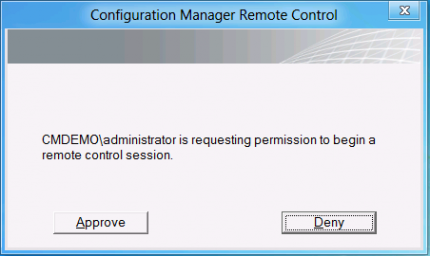Download Configuration Manager Remote Control Client Viewer
Download Configuration Manager Remote Control Client Viewer. Download the latest from Windows, Windows Apps, Office, Xbox,. SCCM Remote Control (Rc.exe) download. Configuration Manager 2007 General https. But you can control the client policies on a granular basis.

I've install SCCM 2012 on a server and have successfully used the Remote Control option to take control of a system I've setup to be managed by SCCM. Now, I don't want to have to log in to a server every time I want to access this client...is there a way to run the Remote Control Viewer client on my desktop OS so I can take remote control of systems rather than having to remote in from the server? This seems like very basic functionality...but I haven't been able to figure it out thus far.
Download Configuration Manager Remote Control Client Viewer
1 Answer
When you run the SCCM installer on your workstation, choose the option to Install Configuration Manager console. Now you can run the console from your own workstation instead of using remote desktop to the server.
This screenshot is from Beta 1, but it looks the same.

Not the answer you're looking for? Browse other questions tagged remote-desktopsccmremote-desktop-servicessystem-center or ask your own question.
-->Applies to: System Center Configuration Manager (Current Branch)
This procedure describes configuring the default client settings for remote control. These settings apply to all computers in your hierarchy. If you want these settings to apply to only some computers, assign a custom device client setting to a collection that contains those computers. For more information a see How to configure client settings in System Center Configuration Manager.
To use Remote Assistance or Remote Desktop, it must be installed and configured on the computer that runs the Configuration Manager console. For more information about how to install and configure Remote Assistance or Remote Desktop, see your Windows documentation.
To enable remote control and configure client settings
In the Configuration Manager console, choose Administration > Client Settings > Default Client Settings.
On the Home tab, in the Properties group, choose Properties.
In the Default dialog box, choose Remote Tools.
Configure the remote control, Remote Assistance and Remote Desktop client settings. For a list of remote tools client settings that you can configure, see Remote Tools.
You can change the company name that appears in the ConfigMgr Remote Control dialog box by configuring a value for Organization name displayed in Software Center in the Computer Agent client settings.
Client computers are configured with these settings the next time they download client policy. To initiate policy retrieval for a single client, see How to manage clients in System Center Configuration Manager.
Enable keyboard translation
By default, Configuration Manager transmits the key position from the viewer’s location to the sharer’s location. This can present a problem for keyboard configurations that differ from viewer to sharer. For example, a viewer with an English keyboard would type an “A”, but the sharer’s French keyboard would provide a “Q”. You now have the option of configuring remote control so that the character itself is transmitted from the viewer’s keyboard to the sharer, and what the viewer intends to type arrives at the sharer.
To turn on keyboard translation, in Configuration Manager Remote Control, choose Action,and choose Enable keyboard translation to transmit key position.
Note
Special keys, such as ~!#@$%, will not be translated correctly.
Keyboard shortcuts for the remote control viewer
| Keyboard shortcut | Description |
|---|---|
| Alt+Page Up | Switches between running programs from left to right. |
| Alt+Page Down | Switches between running programs from right to left. |
| Alt+Insert | Cycles through running programs in the order that they were opened. |
| Alt+Home | Displays the Start menu. |
| Ctrl+Alt+End | Displays the Windows Security dialog box (Ctrl+Alt+Del). |
| Alt+Delete | Displays the Windows menu. |
| Ctrl+Alt+Minus Sign (on the numeric keypad) | Copies the active window of the local computer to the remote computer Clipboard. |
| Ctrl+Alt+Plus Sign (on the numeric keypad) | Copies the entire local computer's window area to the remote computer Clipboard. |